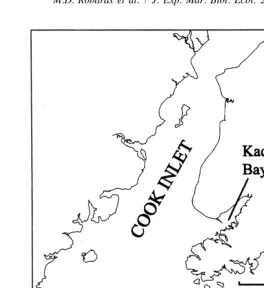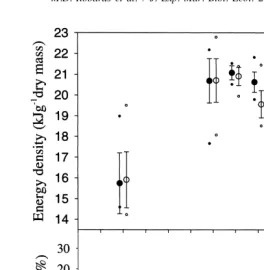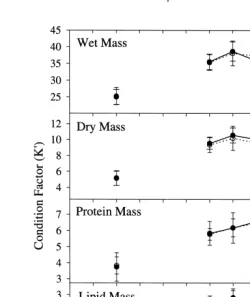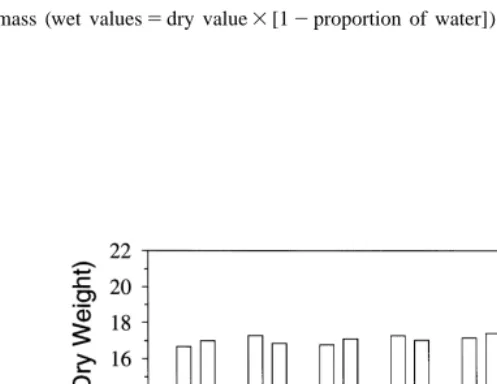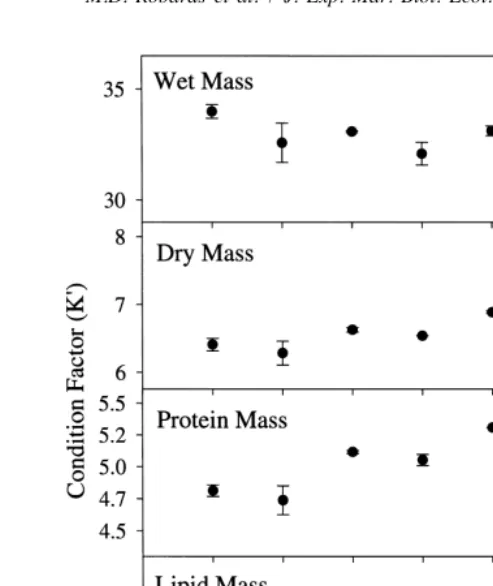L
Journal of Experimental Marine Biology and Ecology 242 (1999) 245–258
www.elsevier.nl / locate / jembe
Changes in proximate composition and somatic energy
content for Pacific sand lance (Ammodytes hexapterus) from
Kachemak Bay, Alaska relative to maturity and season
a ,*,1 b a c
Martin D. Robards , Jill A. Anthony , George A. Rose , John F. Piatt
a
Fisheries Conservation, Fisheries and Marine Institute, Memorial University of Newfoundland, St. John’s,
NF, Canada A1B 3X5
b
Oregon State University Department of Fisheries and Wildlife, 104 Nash Hall, Oregon State University,
Corvallis, OR 97331, USA
c
U.S.G.S. Biological Resources Division, Alaska Biological Sciences Center, 1011 E. Tudor Road,
Anchorage, AK 99503, USA
Received 19 May 1999; received in revised form 1 June 1999; accepted 21 July 1999
Abstract
Mean dry-weight energy values of adult Pacific sand lance (Ammodytes hexapterus) peaked in
21 21
spring and early summer (20.91 kJg for males, 21.08 kJg for females), then declined by about
21 21
25% during late summer and fall (15.91 kJg for males, 15.74 kJg for females). Late summer declines in energy density paralleled gonadal development. Gender differences in energy density (males,females) were only apparent from August to October. Adult sand lance spawn in October, entering the winter with close to their minimum whole body energy content. Juvenile sand lance exhibited a relatively constant protein to lipid ratio until they reached 80 mm fork length. Thereafter, relative proportions of protein remained constant while lipid proportions increased significantly. Dry weight energy densities of juveniles increased from a minimum 16.67
21 21
kJg to a maximum of 19.68 kJg , and (per g) are higher than adults in late summer. The seasonal food value of adult sand lance to predators varies markedly, but maximum energetic value coincides with important feeding periods for marine mammals, fish, and seabirds. Published by Elsevier Science B.V.
Keywords: Ammodytes hexapterus; Bioenergetics; Condition index; Pacific sand lance; Proximate composition; Seasonal variation
*Corresponding author. Tel.: 11-907-786-3512; fax: 11-907-786-3636.
E-mail address: martin [email protected] (M.D. Robards)
]
1
Present address: U.S.G.S. Biological Resources Division, Alaska Biological Sciences Center, 1011 E. Tudor Road, Anchorage, AK 99503, USA.
1. Introduction
Pacific sand lance (Ammodytes hexapterus) are common in many nearshore areas of the Gulf of Alaska and Bering Sea and are a principle prey for many marine birds, commercial fish, and marine mammals (Field, 1988; Springer, 1991; Piatt and Anderson, 1996; Blackburn and Anderson, 1997; Robards et al., 1999b). Despite the food web importance of sand lance, seasonal or geographic variability in their nutritional value is poorly known. Such knowledge is critical for a better understanding of trophic interactions in the North Pacific environment.
Adult sand lance are considered a high-quality forage fish (Anthony and Roby, 1997; Van Pelt et al., 1997). However, their value as prey is a function of size and energy
21
density (kJg wet mass) which is determined primarily by lipid content (percent dry mass; Anthony and Roby, 1997). Lipid content varies with season, location, gender, age, feeding rate, and activity level (Soofiani and Hawkins, 1985; Anthony and Roby, 1997). Marked seasonal variation in lipid content has been documented for other forage fish including an Atlantic sand lance (A. marinus; Hislop et al., 1991), capelin, (Mallotus villosus; Jangaard, 1974), herring (Clupea harengus; Paul et al., 1998a) and several freshwater species (Bryan et al., 1996). Seasonal energy storage is typically related to environmental production cycles (Dygert, 1990), as a consequence of intense feeding during secondary production blooms. With sand lance, however, these cycles of energy storage may be out of phase and lead physiological processes such as spawning, which occurs about four months after the spring primary production bloom (Damkaer, 1977; Dick and Warner, 1982).
In this paper we examine energy storage in relation to sexual development and winter dormancy of adults, plus energetic changes during development in juveniles.
2. Methods
Sand lance were sampled from Kachemak Bay in Lower Cook Inlet, Alaska (Fig. 1) where we were studying breeding seabirds. We collected them from intertidal substrates (by random digging at known habitat beaches on extreme low tides) and by beach seine (Robards et al., 1999b). Adult sand lance were collected in February, and then monthly from June to November in Kachemak Bay. We confirmed adults collected in October were in pre-spawning condition by the appearance of gonads and field observations (Robards et al., 1999a).
Sand lance were measured (fork length, mm), blotted dry, weighed (60.01 g), bagged individually, and frozen. Gonads were excised from partially-thawed individuals to prevent rupture. Ovaries and testes were identified using a dissecting microscope and weighed (60.001 g). Gonads were retained with the rest of the body for proximate analysis.
M.D. Robards et al. / J. Exp. Mar. Biol. Ecol. 242 (1999) 245 –258 247
Fig. 1. Location of Kachemak Bay and Cook Inlet, Alaska.
CrystalBond thermal resin. Age determinations were based on the otolith interpretations of Macer (1966) and Scott (1973). Based on January 1 hatch date (Dick and Warner, 1982), first year sand lance were designated as age group-0, second-year sand lance as age group-1, up to the seventh-year as age group-6. These age groups were divided into juveniles (group-0; sexually immature) and adults (groups 1–6; sexually mature; Robards et al., 1999a).
Adult sand lance were processed individually for proximate composition, whereas juveniles were analyzed in batches of 10 (5 mm size classes) because of their small size. Two replicates were made for each size class. Sand lance were dried at 608C to constant mass in a convection oven and reweighed to determine water content. Lipid content of dry samples was determined by solvent extraction using a soxhlet apparatus and a solvent system of 7:2 hexane / isopropyl alcohol (Radin, 1981). Lean dry samples were ashed in a muffle furnace to determine ash-free lean dry mass (AFLDM). AFLDM is 94% protein (Montevecchi et al., 1984), and hereafter referred to as protein. Energy
21
density (kJg dry mass) and energy content (kJ / fish) were calculated from proximate composition (water, lipid, ash-free lean dry matter, and ash), using published energy
21 21
21
1984; Hislop et al., 1991; Van Pelt et al., 1997) we report results as kJg dry mass. All dry mass: wet mass relationships passed through the origin. Slopes indicated that dry weights of both adult and juvenile sand lance were 25 percent of their wet weights
2 2
(r 50.87, N5242; r 50.99, N514, respectively).
A modified monthly gonadosomatic index (GSI; Nikolsky, 1963) was used to quantify seasonality of reproduction for stages 1 through 6 where GSI5(gonad weight / gonad-free body weight)3100. Condition of sand lance in relation to wet, dry, lipid, and protein mass were calculated using a modified Fulton condition factor (K9) proposed by
7 3
Bagenal and Tesch (1978) where K9 5mass310 /(length) . We used the Student t-test to compare energetic values between sexes, time periods, and regions.
3. Results
3.1. Seasonal variation
Sand lance collected in February were emaciated with no visible fat reserves. By June and July, sand lance had observable mesenteric fat, which then declined until spawning when no mesenteric fat was observed. Proximate composition analyses confirmed these visual observations. Lipid content declined from July through November and February
21
(Table 1). As expected, (Van Pelt et al., 1997) energy density (kJg ) was inversely correlated with water content (water content559.9 2 [0.543total energy density],
2
r 50.81, P,0.01, n5267).
21
Energy densities for individual adults ranged from a high of 22.79 kJg dry mass in
21
June to a low of 14.23 kJg dry mass in February. Mean energy densities declined by
21 21
about 25% from a peak in July (20.91 kJg males, 21.08 kJg females) through to
21 21
November, with lowest values observed in February (15.91 kJg males, 15.74 kJg females). Energy density declined significantly (P,0.001), 13.1% for females and 16.4% for males between July and October, as gonadal development (GSI) increased (Fig. 2), in preparation for spawning. Energy densities for females were significantly (P,0.001) higher than for males in August, September, and October. Energy densities were further reduced by 8.6% in females and 4.7% in males in October; corresponding to the onset of spawning.
Pooled samples from June and July (no significant difference in energy density between months, sexes, or stage of development; P’s.0.05) only exhibited a weak
2
M
Mean (SD) monthly proximate composition values for adult male and female sand lance collected in Lower Cook Inlet during 1996
a b b b
Month Sex N Age Length GSI (%) Dry mass (g) % Water % Lipid % Protein % Ash Energy density
21 b
21
Fig. 2. Monthly energy density (kJg dry mass) and gonadosomatic index (GSI) for adult male (s) and female (d) sand lance collected in Kachemak Bay. Error bars are means6standard deviation; small circles are range of data.
declined more rapidly for males than females. Lipid declines paralleled gonad develop-ment (Fig. 2), and for both events, males preceded females by about one month.
3.2. Juvenile sand lance
21
Energy density of juvenile sand lance ranged from 16.67 kJg at 55–59 mm to 19.68
21
kJg at 85–89 mm (Table 2). The largest juveniles collected in August were similar in energy density (per g) to adult sand lance, although approximately one sixth the dry mass. Juvenile energy densities were inversely correlated with water content (water
2
M.D. Robards et al. / J. Exp. Mar. Biol. Ecol. 242 (1999) 245 –258 251
Fig. 3. Seasonal condition factor (K9) for male (? ?s? ?) and female (–d–) sand lance collected in Kachemak Bay. Error bars are means6one standard deviation. Vertical dashed line indicates time of spawning (Robards et al. 1999).
4. Discussion
Adult sand lance display a seasonal energy cycle with a 31% increase in energy
21
density (kJg ) between February and June. Peak energy values reported here were
˚
similar to those for Atlantic sand lance (e.g., Hislop et al., 1991; Martensson et al., 1996). The seasonal increase corresponds to the spring plankton bloom in April and May (Larrance et al., 1977), like another Alaskan species, yellowfin sole (Pleuronectes asper; Paul et al., 1993). Lipid content of other sand lance species also increases rapidly prior to summer (e.g., A. personatus, Sekiguchi, 1977; and A. marinus, Hislop et al., 1991). Energy density was not significantly related to fish length although a weak positive
2
relationship was observed (r 50.13). This appears normal for many marine prey
2
Table 2
Mean proximate composition values for juvenile sand lance collected in Kachemak Bay during 1996
a b c c c
Size group Rep. Length Dry % Water % Lipid % Protein % Ash Energy
(mm) mass density
21 c
mm S.D. (g) (kJg )
55–59 1 56.7 0.5 1.15 79.6 5.9 80.6 14.3 16.67
2 57.7 0.5 1.25 79.1 7.0 79.9 14.0 16.99
60–64 1 61.8 0.4 1.52 79.4 8.5 78.3 14.4 17.28
2 62.9 0.4 1.52 79.7 7.2 78.8 15.1 16.85
65–69 1 67.8 0.3 2.05 78.9 6.3 80.3 14.3 16.78
2 67.1 0.4 2.01 78.9 7.8 78.9 14.5 17.10
70–74 1 72.7 0.4 2.51 78.3 8.3 78.8 14.1 17.28
2 71.8 0.4 2.42 78.8 7.3 79.6 14.2 17.03
75–79 1 77.7 0.4 3.22 78.0 7.6 79.5 13.9 17.15
2 76.8 0.3 3.13 78.1 8.7 78.6 13.9 17.40
80–84 1 82.2 0.5 3.89 76.9 11.2 76.9 13.4 18.09
2 82.5 0.4 4.26 75.8 14.7 74.2 13.0 19.00
85–89 1 86.8 0.5 4.98 76.0 15.7 73.4 13.0 19.23
2 86.9 0.3 4.95 75.3 17.5 71.9 12.9 19.68
a
Each replicate consists of a pooled sample of 10 fish.
b
Fresh wet mass.
c
Dry mass (wet values5dry value3[12proportion of water]).
21
M.D. Robards et al. / J. Exp. Mar. Biol. Ecol. 242 (1999) 245 –258 253
Fig. 5. Relationship between size and condition factor (K9) for juvenile sand lance collected in Kachemak Bay. Error bars are mean and range of the two samples for each size-class.
Female sand lance expend more reproductive energy than males due to egg production, which requires greater accumulation of reserves (Love, 1980). Pinto (1984) also observed significant loss of lipid prior to spawning by captive sand lance. Many other species (such as cod) loose about 30% of their energy during, rather than prior to spawning (Smith et al., 1990). Although gonad production may contribute to the summer energetic loss, sand lance also reduce their feeding, as evidenced by late summer declines in catch-per-unit-effort and frequency-of-capture (Winslade, 1974; Robards et al., 1999b). As noted for Japanese sand lance (A. personatus; summarized in Field, 1988) adult sand lance may compete with recruiting juveniles in the nearshore area. Furthermore, feeding may be further reduced during the final stages of maturation due to sheer volume of gonads (as observed in gadids [Love, 1980] and herring [Clupea harengus; Bradford, 1993]). Prior to spawning, A. hexapterus gonads were turgid and filled the body cavity completely. Captive adult A. personatus survived for over two months unfed, so they can endure long fasts (Inoue et al., 1967).
lance begin the winter season in poor condition. Without plentiful food supplies (Damkaer, 1977), and with limited reserves for metabolism, sand lance remain dormant in nearshore substrates through the winter (Robards, pers. obs.). During winter they reduce metabolism (Quinn and Schneider, 1991), prolong gut evacuation times (Ciannelli, 1997), and lipids are mobilized (Love, 1980) prior to metabolizing protein (Maddock and Burton, 1994). Sand lance are regarded as a high-protein fish, as protein generally constitutes greater than 15% of wet mass (Stansby, 1976). The proportionally high protein content compared to many other fish species may be an adaptation to low food intake periods. Utilization of the supplemental protein (Maddock and Burton, 1994) would provide an additional buffer to cover metabolic needs during fasting. Protein content varied seasonally by over 14% (dry mass) in adult sand lance from Kachemak Bay.
Accounting for seasonal variability in energy content is critical when modeling
˚
trophic energy flow (Martensson et al., 1996). Excluding Myctophidae which have unusually high lipid content, the seasonal variation we observed was as profound as inter-specific values reported for other North Pacific forage fish (Van Pelt et al., 1997; Anthony and Roby, 1997). Consequently, over 4 to 5 months, adult sand lance range from a relatively high to comparatively low value forage fish.
Juvenile sand lance less than 80 mm apparently channel lipid reserves into growth. As their size increases, larger fish are probably less susceptible to predation (Parker, 1971). Subsequently, juveniles develop lipid reserves rapidly in lieu of growth, as observed for A. personatus (Sekiguchi, 1977), which makes the transition at a shorter length (45–50 mm). While the energy density of juvenile sand lance is initially low, late summer values exceed those of adult males and match those of adult females. Juveniles have far less protein to buffer against starvation than adults, and late-summer accumulation of lipids may be critical for winter survival. Juvenile walleye pollock (Theragra chalcogramma) is another key forage fish in the Gulf of Alaska with mean energy content (3.4–4.0
21
kJg wet wt; Paul et al., 1998b) somewhat lower than juvenile sand lance. In contrast to sand lance, juvenile pollock allocate considerable energy into summer growth in length, but do not develop energy stores for over-wintering. Despite this fact, juvenile pollock maintain or improve their energy content over winter suggesting continued feeding for this species (Paul et al., 1998b).
Dramatic seasonal variations in proximate composition has also been documented in various other forage species e.g., herring, Pacific cod (Gadus macrocephalus) and
˚
M.D. Robards et al. / J. Exp. Mar. Biol. Ecol. 242 (1999) 245 –258 255 Table 3
a
Energy value (kJ / fish) based on mean adult and juvenile fish sizes collected by beach seine
Life-Stage July August
N Wet Wt Length Energy per N Wet Wt Length Energy per
(g) (mm) Fish (kJ) (g) (mm) Fish (kJ)
Adult 300 6.89 120 36.16 1095 7.45 121 36.47
Juvenile 54 0.51 55 2.15 114 1.38 73 5.92
a
Robards (unpubl. data).
summer. Overwintering first-year sand lance may need this advantage, to allow enough growth to facilitate storage of lipid reserves. This is in contrast to juvenile herring for which fall energy content in the neighboring Prince William Sound is markedly higher
21
(5.7 kJg wet mass; Paul et al., 1998a), despite metamorphosing much later than sand lance (July vs. March to May, respectively; Smigielski et al., 1984). Juveniles were the only age-class of sand lance caught pelagically during winter months (in low numbers) during 1996 and 1997 in Kachemak Bay (Robards et al., 1999b) or in the North Sea (Macer, 1966), indicating that at least some individuals may continue foraging during this period.
We emphasize that our results are for one year and a single site within the range of A. hexapterus. Geographic and interannual differences are likely to occur as they do for other forage species such as herring and walleye pollock (Paul et al., 1998a,b). However, the energy values we observed in summer were similar to those reported for sand lance elsewhere, indicating that geographic and annual variability may be less pronounced than seasonal variability. Our results provide an estimate of winter energy values for this species, but sample sizes were small and absolute values should be treated accordingly. The multitude of summer sand lance predators such as breeding seabirds, migratory whales, and commercial fish (Field, 1988), all gain maximum energetic returns from sand lance during June and July. Other important Gulf of Alaska forage species such as herring and capelin which loose up to 80% of their fat during spring spawning (Jangaard, 1974) provide only about two-thirds the energetic return compared to sand lance in early summer (Anthony and Roby, 1997). However, as energy content of sand lance declines during the fall and winter, the concurrently reprovisioning capelin and herring would provide a much greater mass-related energy return, particularly during winter whilst sand lance are also dormant for long periods. Although in July, juveniles are relatively poor prey compared to adults (by a factor of 18:1; Table 3), by August accumulated lipid reserves mean they differ from adults by only a factor of 6:1. Therefore, large schools of juveniles that dominate the nearshore during September and October when adults are scarce (Blackburn and Anderson, 1997; Robards pers. obs.) may be a significant early-winter prey.
Acknowledgements
Oil Spill (EVOS) Trustee Council (Restoration Project 98306), U.S. Geological Survey, and the Alaska Department of Fish and Game. The findings and conclusions presented by the authors are their own. We gratefully acknowledge the assistance of Mike and Phyllis Balough for their help in Seldovia Bay. Thanks go to David Black, Lilly Goodman, Arthur Kettle, Kali Mangel, April Nielsen, and Stephanie Zuniga for help in the field. Mike Geagel (University of Alaska, Fairbanks) and Tom Van Pelt provided logistical help; Dr. Dan Roby and Marc Romano provided laboratory support; Alexander Kitaysky, Nancy Tileston, and Kathy Turco helped with analysis and writing. All sand lance were collected under Alaska Department of Fish and Game permits.
References
Anthony, J.A., Roby, D.D., 1997. Variation in lipid content of forage fishes and its effect on energy provisioning rates to seabird nestlings. In: Baxter, B.R. (Ed.), Alaska Sea Grant College Program AK-SG-97-01, Proceedings of the Symposium on the Role of Forage Fish in the Marine Ecosystem, pp. 725–729.
Bagenal, T.B., Tesch, F.W., 1978. Age and growth. In: Bagenal, T.B. (Ed.), Methods of Assessment of Fish Production in Fresh Waters, Blackwell, Oxford, pp. 101–136.
Blackburn, J.E., Anderson, P.J., 1997. Pacific sand lance growth, seasonal availability, movements, catch variability, and food in the Kodiak-Cook Inlet area of Alaska. In: Baxter, B.R. (Ed.), Alaska Sea Grant College Program AK-SG-97-01, Proceedings of the Symposium on the Role of Forage Fish in the Marine Ecosystem, pp. 409–426.
Bradford, R.G., 1993. Role of spawning condition in the determination of the reproductive traits of spring- and autumn-spawning Atlantic herring from the southern Gulf of St. Lawrence. Can. J. Zool. 71, 309–317. Bryan, S.D., Soupir, C.A., Duffy, W.G., Freiburger, C.E., 1996. Caloric densities of three predatory fishes and
their prey in Lake Oahe South Dakota. J. Freshwater Ecol. 11, 153–161.
Ciannelli, L., 1997. Winter dormancy in the Pacific sand lance (Ammodytes hexapterus) in relation to gut evacuation time. In: Baxter, B.R. (Ed.), Alaska Sea Grant College Program AK-SG-97-01, Proceedings of the Symposium on the Role of Forage Fish in the Marine Ecosystem, pp. 95–104.
Damkaer, D. (Ed.), 1977. Initial zooplankton investigations in Prince William Sound, Gulf of Alaska, and Lower Cook Inlet. Environmental Assessment of the Alaskan Continental Shelf. Annual reports of principal investigators, year ending March 1977, Receptors–fish, littoral, benthos, Volume X, Outer Continental Shelf Environmental Assessment Program, Boulder, Colorado, pp. 137–275.
Dick, M.H., Warner, I.M., 1982. Pacific sand lance, Ammodytes hexapterus Pallas, in the Kodiak island group, Alaska. Syesis 15, 43–50.
Dygert, P.H., 1990. Seasonal changes in energy content and proximate composition associated with somatic growth and reproduction in a representative age-class of female english sole. Trans. Am. Fish. Soc. 119, 791–801.
Field, L.J., 1988. Pacific sand lance, Ammodytes hexapterus, with notes on related Ammodytes species. In: Wilimovsky, N.J., Incze, L.C., Westrheim, S.J. (Eds.), Species synopses: Life histories of selected fish and shellfish of the northeast Pacific and Bering Sea, Washington Sea Grant Program and Fish Res. Inst., Univ. Wash, Seattle, Washington, pp. 15–33.
Inoue, A., Takamori, S., Kuniyuki, K., Kobayashi, S., Nishina, S., 1967. Studies on the fishery biology of sand lance Ammodytes personatus Girard. Bull. Nakai Reg. Fish. Res. Lab. 25, 1–335.
Hislop, J.R.G., Harris, M.P., Smith, J.G.M., 1991. Variation in the calorific value and total energy content of the lesser sandeel (Ammodytes marinus) and other fish preyed on by seabirds. J. Zool. Lond. 224, 501–517. Jangaard, P.M., 1974. The capelin (Mallotus villosus): Biology, distribution, exploitation, utilization, and
M.D. Robards et al. / J. Exp. Mar. Biol. Ecol. 242 (1999) 245 –258 257 Larrance, J.D., Tennant, D.A., Chester, A.J., Ruffio, P.A., 1977. Phytoplankton and primary productivity in the northeast Gulf of Alaska and Lower Cook Inlet. Final Report. Environmental Assessment of the Alaskan Continental Shelf. Annual reports of principal investigators, Receptors — fish, littoral, benthos, Vol. X, Outer Continental Shelf Environmental Assessment Program, Boulder, Colorado.
ˆ
Lawson, J.W., Magalhaes, A.M., Miller, E.H., 1998. Important prey species of marine vertebrate predators of the northwest Atlantic: proximate composition and energy density. Mar. Ecol. Prog. Ser. 164, 13–20. Love, R.M., 1970. The chemical biology of fishes. Vol 1, Academic Press, London.
Love, R.M., 1980. In: Advances 1968–1977, The chemical biology of fishes, Vol. 2, Academic Press, Toronto. Macer, C.T., 1966. Sand eels (Ammodytidae) in the southwestern North Sea: their biology and fishery. Fishery
Invest. Lond. Ser. 2 (24), 1–55.
Maddock, D.M., Burton, M.P.M., 1994. Some effects of starvation on the lipid and skeletal muscle layers of the winter flounder Pleuronectes americanus. Can. J. Zool. 72, 1672–1679.
˚
Martensson, P.-E., Lager Gotaas, A.R., Nordøy, E.S., Blix, A.S., 1996. Seasonal changes in energy density of prey of northeast Atlantic seals and whales. Mar. Mamm. Sci. 12 (4), 635–640.
Montevecchi, W.A., Piatt, J.F., 1984. Composition and energy contents of mature inshore spawning capelin (Mallotus villosus): implications for seabird predators. Comp. Biochem. Physiol. 78A (1), 15–20. Montevecchi, W.A., Ricklefs, R.E., Kirkham, I.R., Gabaldon, D., 1984. Growth energetics of nestling gannets
(Sula bassanus). Auk 101, 334–341.
Nikolsky, G.V., 1963. The Ecology of Fishes, Academic Press, New York, NY.
Parker, R.R., 1971. Size selective predation among juvenile salmonid fishes in a British Columbia inlet. J. Fish. Res. Board of Canada. 25, 757–794.
Paul, A.J., Paul, J.M., Smith, R.L., 1993. The seasonal changes in somatic energy content of Gulf of Alaska yellowfin sole Pleuronectes asper. J. Fish Biol. 43, 131–138.
Paul, A.J., Paul, J.M., Brown, E.D., 1998a. Fall and spring somatic energy content for Alaskan Pacific Herring (Clupea pallasi Valenciennes) relative to age, size, and sex. J. Exp. Mar. Biol. Ecol. 223, 133–142. Paul, A.J., Paul, J.M., Smith, R.L., 1998b. Seasonal changes in whole-body energy content and estimated
consumption rates of age 0 walleye pollock from Prince William Sound. Alaska Est. Coastal Shelf Sci. 47, 251–259.
Piatt, J.F., Anderson, P., 1996. Response of common murres to the Exxon Valdez oil spill and long-term changes in the Gulf of Alaska marine ecosystem. Am. Fish. Soc. Symp. No. 18, 720–737.
Pinto, J., 1984. Laboratory spawning of Ammodytes hexapterus from the Pacific coast of North America with a description of its eggs and early larvae. Copeia 1984, 242–244.
Quinn, T., Schneider, D.E., 1991. Respiration of the teleost fish Ammodytes hexapterus in relation to its burrowing behavior. Comp. Biochem. Physiol. 98, 71–75.
Radin, N.F., 1981. Extraction of tissue lipids with a solvent of low toxicity. Meth. Enzymol. 72, 5–7. Robards, M.D., Piatt, J.F., Rose, G.A., 1999a. Maturation, fecundity, and intertidal spawning of Pacific sand
lance (Ammodytes hexapterus) in the northern Gulf of Alaska. J. Fish. Biol. 54, 1050–1068.
Robards, M.D., Piatt, J.F., Kettle, A.B., Abookir, A.A., 1999b. Temporal and geographic variation in fish communities of Lower Cook Inlet, Alaska. Fish. Bull. 97(4), xx–xx.
Schmidt-Nielsen, K., 1997. Animal physiology: Adaptation and environment, 5th ed., Cambridge University Press, New York.
Scott, J.S., 1973. Otolith structure and growth in northern sand lance Ammodytes dubius, from the Scotian Shelf. Int. Comm. Northwest Atl. Fish. Res. Bull. 10, 107–115.
Sekiguchi, H., 1977. On fat deposits of the spawners of sand eels in Ise Bay central Japan. Bulletin of the Jap. Soc. Sci. Fish. 43, 123–127.
Smigielski, A.S., Halavik, T.A., Buckley, L.J., Drew, S.M., Laurence, G.C., 1984. Spawning, embryo development, and growth of the American sand lance (Ammodytes americanus) in the laboratory. Mar. Ecol. Prog. Ser. 14, 287–292.
Smith, R.L., Paul, A.J., Paul, J.M., 1990. Seasonal changes in energy and the energy cost of spawning in Gulf of Alaska Pacific cod. J. Fish. Biol. 36, 307–316.
Springer, A.M., 1991. Seabird relationships to food webs and the environment: Examples from the North Pacific. Can. Wildl. Serv. Occas. Pap. 68, 39–48.
Stansby, M.E., 1976. Chemical characteristics of fish caught in the northeast Pacific Ocean. Mar. Fish. Rev. 38, 1–11.
Tocher, D.R., Sargent, J.R., 1984. Analyses of lipids and fatty acids in ripe roes of some northwest European marine fish. Lipids 19, 492–499.
Van Pelt, T.I., Piatt, J.F., Lance, B.K., Roby, D.D., 1997. Proximate composition and energy density of some North Pacific forage fishes. Comp. Biochem. Physiol. 118A, 1393–1398.
